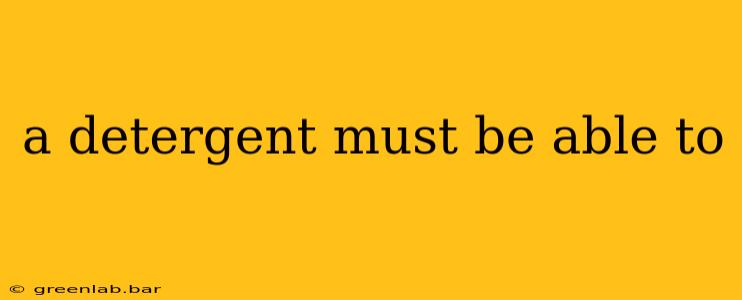Detergents are essential household items, but their effectiveness hinges on a variety of factors. Understanding what a detergent must be able to do is key to choosing the right product for your needs and appreciating the sophisticated chemistry behind these everyday cleaning agents. This article delves into the core properties and performance expectations of a high-quality detergent.
Core Cleaning Capabilities: What a Detergent Must Do
At its heart, a detergent must effectively remove dirt, stains, and grime from fabrics and surfaces. This seemingly simple task involves several crucial capabilities:
1. Emulsification and Suspension:
A detergent must be able to emulsify oils and grease, breaking them down into tiny droplets that are easily dispersed in water. This prevents them from redepositing onto the fabric. Simultaneously, it needs to suspend these emulsified particles, preventing them from settling back onto the cleaned surface. Think of it as keeping the dirt floating in the wash water until it's rinsed away.
2. Wetting and Penetration:
Effective detergents possess excellent wetting properties, allowing the cleaning solution to easily penetrate fabrics and spread evenly across the surface. This ensures that the detergent can reach and lift away dirt from within the fibers, not just the surface. Without proper wetting, cleaning efficacy is significantly reduced.
3. Soil Removal and Lifting:
The primary function of a detergent is, of course, soil removal. This involves not just loosening the dirt but actively lifting it away from the fabric. The detergent molecules work by reducing the surface tension between the soil and the fabric, allowing the soil particles to be released into the wash water. This process is heavily influenced by the detergent's ability to emulsify and suspend soil.
4. Stain Removal:
While not all detergents are specifically formulated for stain removal, a good detergent should demonstrate at least a baseline ability to remove common stains. This capability is often enhanced through the inclusion of specific enzymes or other additives designed to tackle particular types of stains (e.g., protein stains, oily stains).
Beyond Basic Cleaning: Additional Essential Properties
Beyond the core cleaning functions, several other characteristics determine a detergent's overall performance and desirability:
5. Biodegradability and Environmental Friendliness:
Modern detergents prioritize biodegradability. This means the detergent's components break down naturally in the environment, minimizing their impact on ecosystems. Look for detergents that are formulated with environmentally friendly ingredients and are labeled as biodegradable.
6. Gentle on Fabrics:
Detergents should clean effectively without damaging the fabric. They should be formulated to avoid excessive wear and tear, color fading, or fiber damage. The choice of surfactants and other ingredients significantly influences this aspect.
7. Pleasant Scent and Ease of Use:
While not strictly a cleaning function, a pleasant scent and ease of use enhance the consumer experience. Many detergents include fragrances, but it's crucial to choose ones that are also hypoallergenic to minimize potential skin irritation. Easy dispensing and solubility also contribute to ease of use.
Conclusion: A Holistic Approach to Detergent Performance
Selecting the right detergent involves considering its entire performance profile. While basic cleaning capabilities are paramount, factors like biodegradability, fabric gentleness, and user-friendliness also contribute to its overall quality. Understanding these essential aspects ensures you choose a detergent that effectively cleans while also meeting your specific needs and environmental considerations.

